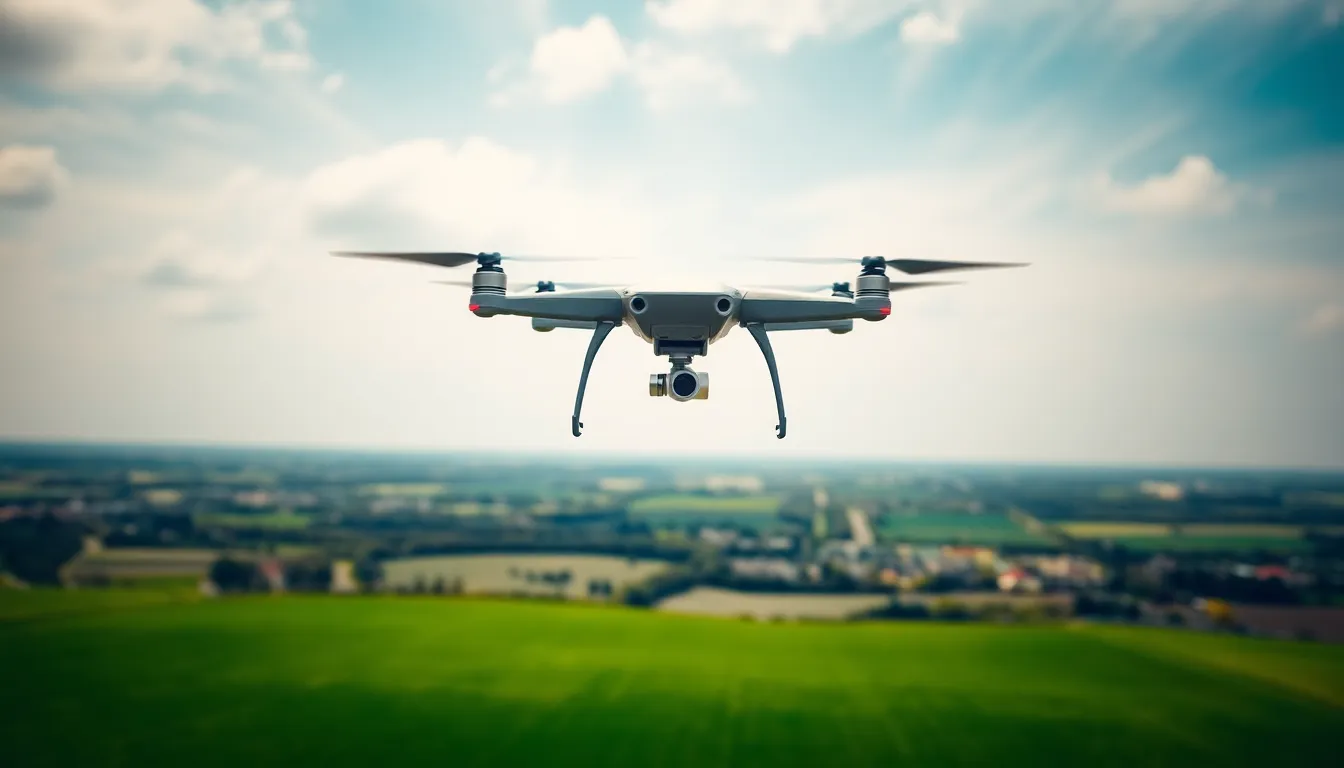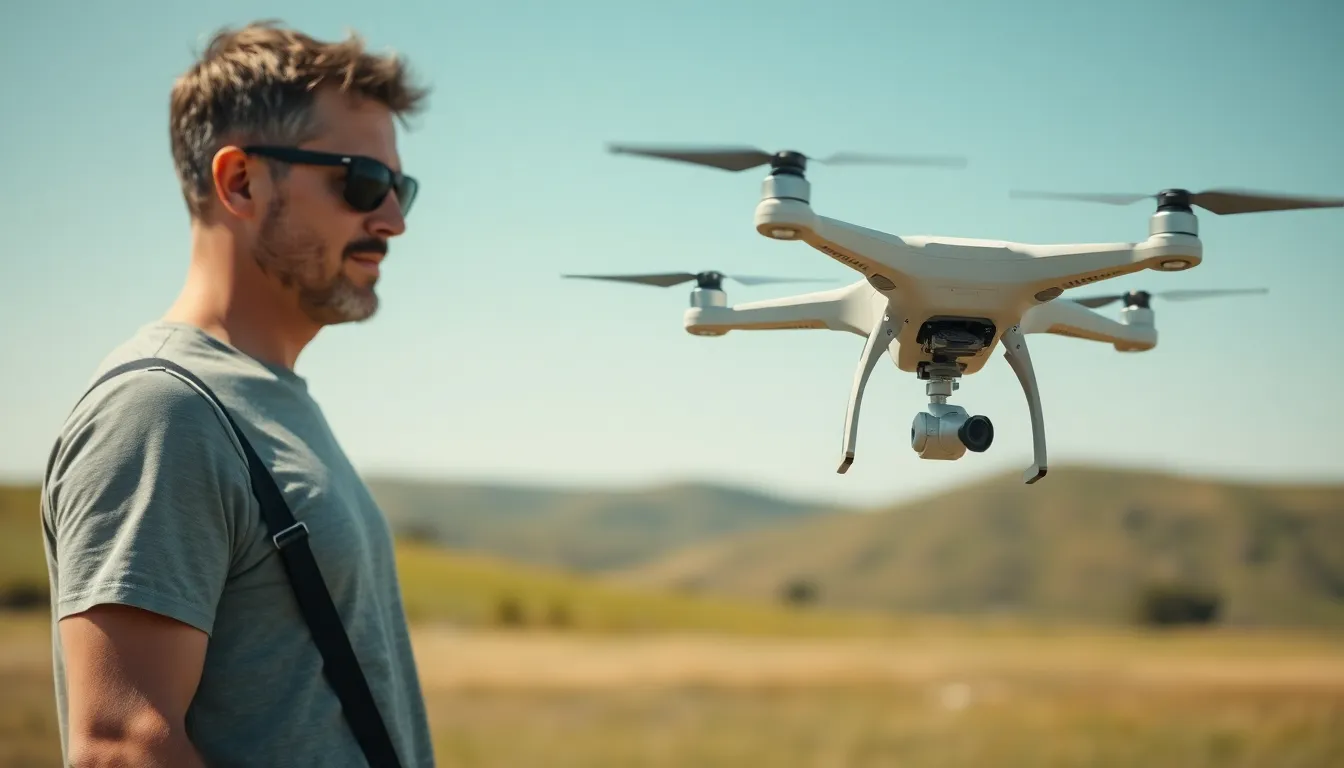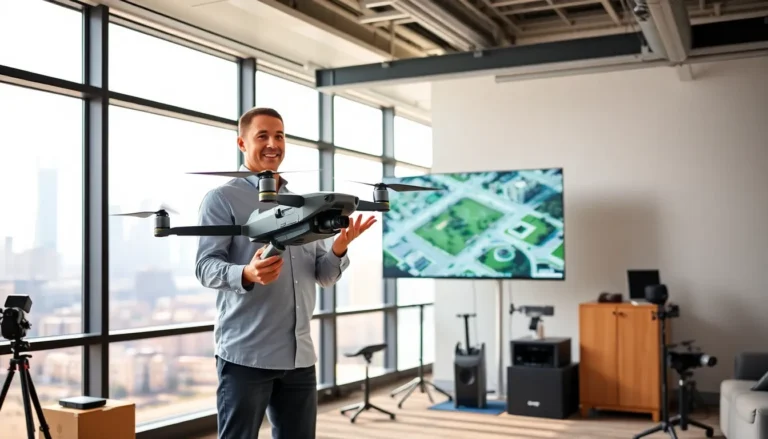In a world where drones buzz around like over-caffeinated bees, understanding drone flight dynamics isn’t just for engineers and tech geeks. It’s for anyone who’s ever dreamed of soaring through the skies—or at least capturing that perfect aerial selfie. These flying marvels have transformed everything from photography to delivery services, and knowing how they dance through the air can turn a casual flyer into a drone whisperer.
Table of Contents
ToggleOverview of Drone Flight Dynamics
Understanding drone flight dynamics involves knowledge of several key concepts that govern how drones operate in the air. Aerodynamics plays a crucial role, as it influences how air flows over the drone’s body, propelling it upward or downward. Lift occurs when the drone’s rotors spin, creating a difference in air pressure above and below them.
Thrust production is another important factor. Each rotor generates thrust through rotation, allowing the drone to move in various directions. Controlling this thrust enables operators to navigate smoothly through the air.
Equally significant is weight, as it directly impacts lift and thrust. The drone’s weight, influenced by components such as batteries and payloads, must be managed to maintain optimal flight performance.
Additionally, stability is vital for maintaining controlled flight. Gyroscopes and accelerometers help detect and correct any tipping or swaying, ensuring a steady flight path. Pilots benefit from this understanding, as it aids in making real-time adjustments during operation.
Finally, understanding drone flight dynamics enhances user experience. Beginners gain valuable insights into how to operate drones effectively, while seasoned users can optimize their performance for various applications, such as aerial photography, surveying, or package delivery.
Knowledge of flight dynamics empowers drone operators, allowing them to adapt to different environments and conditions. Overall, this foundational understanding proves essential for anyone engaging with drone technology.
Key Principles of Flight

Understanding the key principles of flight is crucial for effective drone operation. Knowledge of lift, thrust, drag, and weight shapes a pilot’s ability to manage drones in various conditions.
Lift and Thrust
Lift arises from rotor blade design and speed. As a drone’s rotors spin, they create a pressure difference, allowing air to flow over and under the blades. Thrust provides the necessary force to move the drone in a chosen direction. Each rotor’s speed adjustment governs the direction and speed of flight. For instance, increasing thrust propels the drone upward, while a decrease causes descent. This balance between lift and thrust determines a drone’s altitude and maneuverability.
Drag and Weight
Drag opposes the drone’s movement through air, influenced by shape and speed. A streamlined design reduces this resistance, enhancing efficiency. Weight affects how much lift a drone requires to maintain altitude. Heavier drones necessitate greater lift to overcome their weight. Understanding these forces allows pilots to optimize flight performance and energy consumption. Adjusting flight paths based on drag helps maintain stable control while flying. This knowledge aids pilots in making informed decisions during various flying conditions.
Types of Drones and Their Flight Characteristics
Understanding various types of drones and their unique flight characteristics enhances operational effectiveness. Different designs cater to specific applications and environments.
Quadcopters
Quadcopters utilize four rotors to achieve lift and maneuverability. Their design provides excellent stability, making them ideal for aerial photography and recreational flying. Rotor speed adjustments allow for rapid changes in direction and altitude. An operator can intuitively control a quadcopter with minimal training, fostering a user-friendly experience. Typically, quadcopters exhibit vertical flight capabilities, making takeoff and landing straightforward. Weight distribution impacts performance; thus, thoughtful payload management is essential for optimal functionality.
Fixed-Wing Drones
Fixed-wing drones feature a traditional airplane structure, relying on wings for lift. Their aerodynamic shape allows for efficient long-distance travel and extended flight times. Operators benefit from enhanced speed and range compared to quadcopters. Fixed-wing designs excel in agricultural monitoring and surveying tasks. Though they require a runway or launch mechanism, these drones cover larger areas in less time. Pilots must manage energy efficiency carefully, as flight duration directly correlates with battery life and operational effectiveness.
Factors Affecting Flight Dynamics
Understanding the factors that affect flight dynamics is crucial for optimizing drone performance. The following elements significantly influence how drones operate in various environments.
Weather Conditions
Weather conditions play a significant role in drone flight dynamics. Wind speed affects stability and control, with strong winds causing turbulence that disrupts flight paths. Rain can hinder visibility and impact sensor functionality, making navigation more challenging. Temperature influences battery performance, as colder weather can reduce flight times. Humidity levels also impact lift generation, altering air density and leading to variations in lift. Pilots must assess these conditions prior to flying to ensure safe and effective operations.
Weight Distribution
Weight distribution is vital for maintaining balance during flight. Uneven weight placement can cause instability, leading to erratic behavior in the air. Proper center of gravity positioning enhances maneuverability and responsiveness. Adjusting payloads, such as cameras or additional equipment, requires careful consideration of their impact on weight distribution. Understanding these dynamics enables pilots to optimize performance, reduce power consumption, and increase flight efficiency. Maintaining a balanced weight distribution ensures smoother flight and better control in varying conditions.
Control Systems in Drones
Control systems play a vital role in a drone’s performance and functionality. They determine how a drone responds to pilot inputs and environmental conditions.
Remote Control vs. Autonomous Systems
Remote control systems allow users to manually operate drones from a distance. Pilots can directly influence a drone’s movements through a handheld transmitter, providing real-time control. However, autonomous systems leverage pre-programmed algorithms to navigate without human intervention. These systems rely on GPS and onboard sensors to adapt to surroundings, ensuring efficient operation.
Combining both methods enhances flexibility. Many drones feature hybrid systems, supporting manual overrides in autonomous flight. Users can thus engage in complex missions while maintaining safety through manual control options. Understanding the differences informs users about the appropriate control system for specific tasks, such as aerial photography or surveying.
Mastering drone flight dynamics opens up a world of possibilities for both casual users and professionals alike. By understanding the fundamental principles of aerodynamics, thrust, and weight management, pilots can enhance their flying skills and achieve better results in various applications.
Recognizing how different drone types operate and their unique characteristics enables users to select the right model for their specific needs. Additionally, awareness of external factors like weather conditions and weight distribution can significantly impact flight performance.
With this knowledge, drone enthusiasts can navigate challenges more effectively, ensuring smoother flights and optimized energy consumption. As drone technology continues to evolve, staying informed about flight dynamics will empower users to fully harness the potential of their devices.





